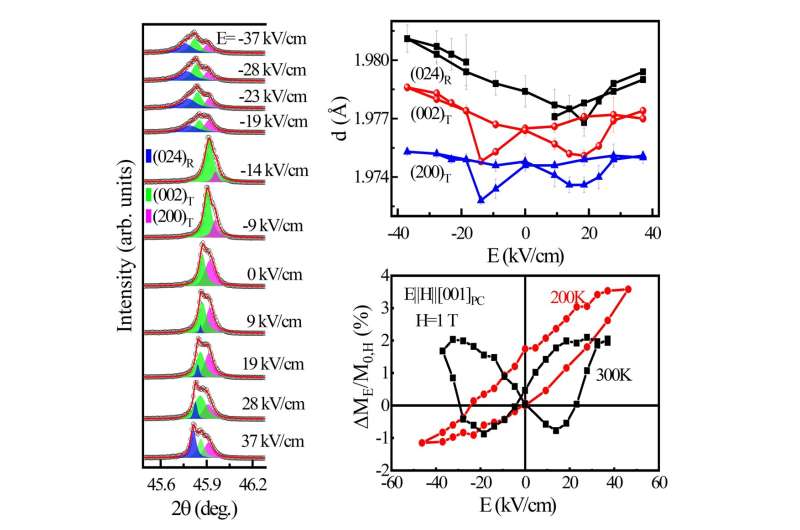This article has been reviewed according to Science X's editorial process and policies. Editors have highlighted the following attributes while ensuring the content's credibility:
fact-checked
peer-reviewed publication
trusted source
proofread
Novel single crystals show promising electric field control of magnetism

A research team led by associate Prof. Yin Lihua from the Hefei Institutes of Physical Science of the Chinese Academy of Sciences has demonstrated a clear control of magnetism at low electric fields (E) at room temperature. The E-induced phase transformation and lattice distortion were found to lead to the E control of magnetism in multiferroic BiFeO3-based solid solutions near the morphotropic phase boundary (MPB). The study was published in Acta Materialia.
Multiferroic materials, with magnetic and ferroelectric properties, are promising for multifunctional memory devices. Magnetoelectric-based control methods in insulating multiferroic materials require less energy and have potential for high-speed, low-power information storage applications. BiFeO3 is a room-temperature multiferroic material with potential for use in spintronics devices, but its weak ferromagnetic and magnetoelectric effects and high voltage required for manipulation are weaknesses.
In this study, the researchers grew single crystals of the multiferroic 0.58BiFeO3-0.42Bi0.5K0.5TiO3 (BF-BKT), which lies in the tetragonal region adjacent to the MPB.
"Below the Néel temperature, TN~257.5 K, the BF-BKT crystals showed antiferromagnetic behavior," said Yin, "and at room temperature, we found that the BF-BKT crystals exhibited both short-range magnetic order and long-range ferroelectric order."
At room temperature, the multiferroic BF-BKT single crystals exhibited substantial and consistent control of magnetism with E, where the magnitude of E was significantly smaller than the ferroelectric coercive field.
In addition, high magnetic fields (H) could significantly reduce the degree of E control over magnetism.
It was found that the coupling between magnetism and ferroelectricity in the BF-BKT material can be attributed to both lattice distortion and phase transformation induced by an external E, rather than just ferroelectric domain switching. At high values of H, the converse magnetoelectric effect is weakened due to the suppression of phase transformation caused by the magnetic field.
These results suggest that designing devices based on multiferroics near the MPB could be an effective way to achieve E control of magnetism and even possible low-E switching of magnetism for low-power spintronic applications.
More information: Li-Hua Yin et al, Control of magnetism at low electric fields in multiferroic 0.58BiFeO3-0.42Bi0.5K0.5TiO3 single crystal near morphotropic phase boundary, Acta Materialia (2023). DOI: 10.1016/j.actamat.2023.119044
Journal information: Acta Materialia
Provided by Chinese Academy of Sciences





















